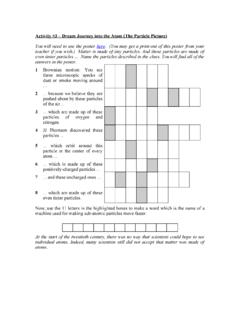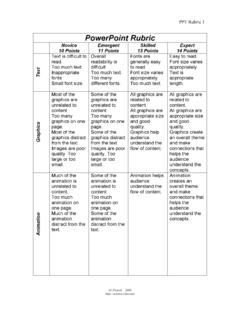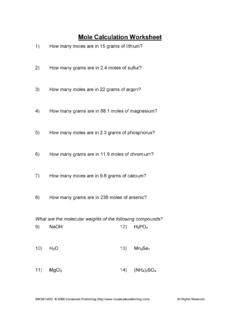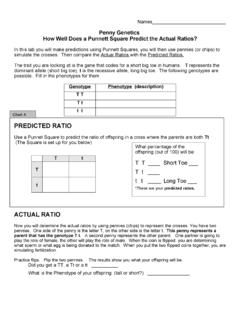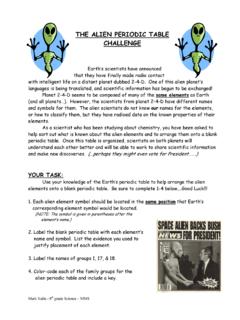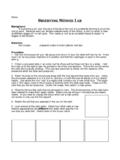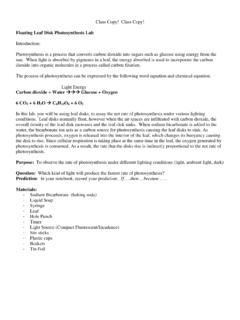Transcription of Density Column Using Recyclable Plastics. - nclark.net
1 Vanderbilt Student Volunteers for Science Density Column Using Recyclable plastics . 7th/8th Grade Spring 2004. Goal: To explain the concepts governing the recycling of plastics , problems encountered in the recycling process due to the different types of plastics used, and to gain an understanding of the differing properties of each type of plastic Using Density to illustrate the concept. The different types of plastics used in this lab will focus on the current six Recyclable types as outlined in the Society of plastics Industry's recycling codes implemented in 1988.
2 Lesson Outline I. Introduction Discuss the general polymer chemistry of all types of plastics . II. Six Types of Plastic Recycling Codes Explain the differing properties of the six types of Recyclable plastics and association with a triangular symbol/number. Use a Density Column to help exhibit the different properties of each type of plastic and demonstrate that Density is a good method to determine the type of plastic. Discuss the wide range of products made from recycled plastics . III. Identifying Unknown Plastic Types Students will test an unknown plastic sample to attempt to determine what type of plastic the sample represents through the use of a Density Column .
3 IV. Discussion of Student's Results Students will make an educated guess about the type of plastic their sample represents with a brief explanation for their conclusion. Briefly discuss some problems faced in the recycling process. Density Column ( Recyclable plastics ).doc Page 1 of 9. Recycling plastics Materials 1 Large Density Column (500 mL graduated cylinder) with rubber band and lid 1 Demo Bag (six total pieces of plastics one piece for each plastic type). 6 Example bottles (one for each type of plastic).
4 1 Corn Syrup (200 mL bottle). 1 Glycerin (200 mL bottle). 1 Water (200 mL bottle) slight yellow hue 1 Castor Oil (200 mL bottle). 1 2-propanol/hamamelis mixture (200 mL bottle) slight green hue 5 6oz jars containing 80mL Corn Syrup (one per group). 5 6oz jars containing 80mL Glycerin (one per group). 5 6oz jars containing 80mL Water (one per group). 5 6oz jars containing 80mL Castor Oil (one per group). 5 6oz jars containing 80mL 2-propanol/water mix (one per group). 5 #1 bags (each bag contains 6 unknown plastic pieces).
5 10 9 tongs 10 8 forceps 5 small plastic bags marked USED . 1 waste container for the demo Column (800ml). 30 Student Handouts 30 Student Data sheets Pre-lesson Setup Split the students into four or five groups (each group should have 4 to 6 students) for the hands-on-activity, later in the lesson. The VSVS volunteers can accomplish the following items, while one volunteer gives the introduction portion of the lesson. a. Setup the large Density Column Demo in the 500ml graduated cylinder. Remove the plastic wrap and rubber band from the top.
6 Save to use at the end of the lesson. Drop in the V piece. Pour a 90ml to 100ml portion of corn syrup from the stock bottle into the center of the vertical graduated cylinder. The goal is to get no corn syrup on the sides of the graduated cylinder. If some gets on the side of the cylinder, allow the corn syrup a couple of minutes to drain down. Drop in the PETE piece. Next, slowly pour a 90ml to 100ml portion of each of the following liquids down the side of the slanted graduated cylinder and add a plastic piece in this order: glycerol, PS, water, HDPE, castor oil, and 2- propanol/hamamelis mixture (commonly known as rubbing alcohol and witch hazel).
7 Allow the liquid to drain down for a minute before pouring the next liquid. Verify that there are five distinct layers in the Column . Each stock bottle contains 200ml which is sufficient to set up the Column twice, if the first attempt does not work. Density Column ( Recyclable plastics ).doc Page 2 of 9. Recycling plastics b. Draw the Density Column (the following diagram) on the board. Make sure that it is large enough for all the students to clearly see the distinct separation of the five liquids. The numbers following the liquids are the Density of that liquid.
8 2-propanol /. hamamelis mix g/ml Castor Oil g/ml Water g/ml Glycerin g/ml Corn Syrup g/ml I. Introduction This lesson is designed to help the students gain an understanding of the plastics found all around them everyday including food containers, furniture, carpets, kitchen utensils, and clothing. Ask the students, Can anyone list some Recyclable materials? . Accept logical responses and direct the conversation toward plastics . Density Column ( Recyclable plastics ).doc Page 3 of 9. Recycling plastics Explain that today, you will discuss those little triangles and numbers found on the bottom of plastic bottles.
9 You will gain an understanding of why local recycling centers do not accept all plastic bottles, and ask that you sort out the bottles by type and remove the caps and paper labels before dropping them off at a recycling center. (Hand out the plastics Information Sheet to the students). Begin by defining all plastics as different types of polymers. Make sure that the students understand the concept of a polymer. [A basic unit (monomer) that is repeated over and over again]. The monomers of the six types of plastics that are discussed today are shown on the handout.
10 Make the distinction that some polymers occur naturally, like proteins and starches, but plastics are synthetic polymers which means that they are man-made. Since plastics are synthetic, they can be manufactured in a controlled manner and given different properties. Some plastic polymers are very hard and rigid (bowling balls, football helmets), while others are soft and flexible (foam mattresses). Some polymers are resistant to heat (adhesives used in aircraft), while others can be readily melted (milk jugs).
